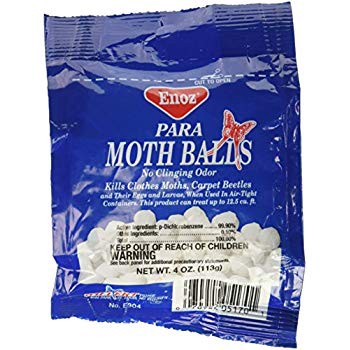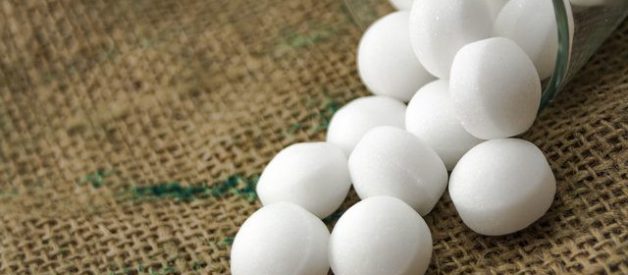
The smell of mothballs, although pungent, is admittedly somewhat nostalgic. For me, it brings me back to my grandmother?s teak wardrobe, a custom-made gift she had received on her wedding day with my late grandfather. I would watch her as she perused through her clothes, picking out which top would best fit the day?s occasion, forever the fashionable woman that I know and love. In the recesses of her wardrobe shelves were white, spherical crystals, hidden away from plain sight but could be smelled upon opening the wardrobe. If either my little sister or I managed to find one and played with it, we would be reprimanded and made to wash our hands twice before being reprimanded again. It doesn?t happen very often, the mothball playing, but from the handful of times that it did happen, both my sister and I knew and understood that we shouldn?t touch mothballs and we definitely shouldn?t put out hands in our mouths if we touched one.
But the odor doesn?t just take me back to my grandmother?s. It also reminded me of my parents? floor-to-ceiling wardrobe, where they kept all their work clothes, day-to-day outfits, and my dad?s airsoft gun (I lived in Indonesia, things were legislatively different back then). I would see those same spherical crystals strewn around the wardrobe shelves, amongst the clothes, tucked away behind my dad?s crisply-ironed work shirts. It also reminded me of my own wardrobe where we kept both my sister?s and my uniforms and daily clothes. Tucked somewhere between the brightly colored floral print shirts and the red-and-white school uniform, the white crystals were essentially ubiquitous to clothes cabinets and daily lives. For both my parents? and my wardrobes, same rules applied: we couldn?t touch them, let alone play with them, and if we accidentally touched them, we definitely shouldn?t put our hands in our mouths.
Like the airsoft gun, the scent left behind on our fingers after handling money, and the ink residue from reading a newspaper, my little sister and I associated these white spheres with death, and death was painful and not good and we should not do anything that would result in death. Also because mom and dad would get mad (and this was perhaps the most effective deterrent).
Mothballs: a(n un)natural part of our lives

Personally, I never gave mind to mothballs. It was simply something that was a part of my life, this nifty little human creation that would keep my clothes looking good after keeping them stored away for months on end despite the stinky smell it gave off and the fact that I would have to wash my stored clothes before I could wear them again. I knew that I shouldn?t play with it because it was dangerous, but I was never told why. As far as I could remember, mothball labels in Indonesia simply stated ?if ingested, call the doctor.? It wasn?t until I learned English and grew a penchant for reading product labels did I understood the gravity of mothball ingestion because American warning labels give a little more direction (and dread) than simply calling the doctor: ?Call the poison control center.?
The thing is, this is a part of many people?s lives, not just mine. Most, if not all, of my relatives use mothballs to prevent clothes moth infestation and losing important or expensive clothes, and many people still use it to this day. Even now, my parents have a handful of mothballs hidden away in their closet and the towel cabinet. Mothballs are economical and an easy option for people who don?t want to find their expensive wool sweaters eaten away when they pull it out of storage. This is part of the reason why I decided to focus on mothballs as my topic; despite the dangers, mothballs are still part of many people?s lives to this day, and whether it is by lack of understanding regarding its effects or willful ignorance, learning about what mothballs could do could potentially improve our current and long-term health.
A note on chemical toxicity and exposure
The dose makes the poison, says Paracelsus, a famous Swiss physician and alchemist who was coined as the father of toxicology. Certainly, when it comes to anything related to foreign chemicals and effects on the human body, your exposure dosage matters. There are two types of exposure when talking about chemicals: acute and chronic.
Imagine a full bucket of water that you will eventually tip over your head. You can do it one of two ways:
- Dunk all the water in one go; or
- Let the water drip over a long period of time over your head.
Option 1 is what could be considered as an acute exposure: you are exposed to all of the water in the bucket in the span of several seconds. Though not necessarily over the span of a few seconds, acute chemical exposure uses the same principle. Acute exposure typically involves exposure of a large amount of toxic substance in the span of several days, usually up to 14 days.
On the opposite, option 2 could be considered as a chronic exposure: you are exposed to very small amount of the water in the bucket over a very long time. With regards to chemicals, chronic exposure means exposure of small amounts of toxic substances in the span of months or even years (exposure is typically considered chronic if it spans for at least one year). So going back to my story above about my personal experience with mothballs, we could consider my exposure type to be chronic.
This distinction is something to keep in mind while reading the rest of this post, as some of the following sections will mention case studies with regards to exposure to the two main active ingredient commonly found in mothballs. As a matter of fact, this distinction is important in general, especially if you are going to do some of your own digging on chemicals and its health effects. Knowing the difference between the two can help you understand what will be at stake and how your health could be affected if you are exposed to certain types of chemicals.
With regards to how much exposure is considered ?safe,? an important note to keep in mind is that for most chemicals, no amount of exposure is technically safe (take lead for example.) However, many environmental health organizations like the CDC and OSHA have released information regarding the minimum exposure level of many chemical substances. These are intended to indicate the lowest amount of chemical exposure required in order for the chemical to be a probable cause of adverse health effects.
What?s a mothball? Why is it harmful?
A simple Google search of the term ?mothball? would give you this definition:
A small pellet of a pungent substance, typically naphthalene, put among stored clothes to keep away moths.
Mothballs can look like little pellets or small spheres, and they are crystal-like and almost always white in color. They can be found in many supermarkets and convenience stores (including CVS Pharmacy and dollar stores) and are generally sold in the aisle where you can find laundry supplies. The smell of mothballs is unmistakable and hard to miss. These solid pellets or spheres directly sublime from solid to gas, and proper use includes keeping it in tightly-lidded containers and out of reach from children and pets. In an airtight containers, the fumes released by mothballs accumulate and effectively work to kill adult clothes moths and moth larvaes. Upon removing clothing items from the containers, clothes should be aired out, thoroughly washed, and properly dried prior to use to eliminate the odor and minimize exposure to the fumes. The National Pesticide Information Center has more information regarding proper use, storage, and information on regulation.
Mothballs are almost entirely (as in 99.99%) made up of one of two chemicals: naphthalene or paradichlorobenzene (also written as p-dichlorobenzene or PDCB). Mothballs made before the mid-1900s were typically made from naphthalene, while those made after mid-1900s were made of the PDCB. The switch in main ingredients was due to the highly flammable characteristic of naphthalene, as well as its apparent nature as a neurotoxin and a carcinogen. PDCB was considered a ?less toxic? alternative to naphthalene, but still came with a long list of side effects if ingested or inhaled on top of also being a potent neurotoxin and a carcinogen. Worth noting: California has deemed both of these chemicals as dangerous and illegal for distribution as noted in the state?s Proposition 65. You can find the full list here.
What?s naphthalene? What can it do to the body?
 They come in heart shapes, too!
They come in heart shapes, too!
Naphthalene is a chemical that is typically found outdoors as a product of engine combustion, meaning that naphthalene is part of the stuff that comes out of the tailpipe of your car. Concerned about your naphthalene exposure outdoors? Don?t be; your primary concern should be your indoor naphthalene exposure, especially if your household uses naphthalene mothballs. Chances are, the amount of naphthalene you?re inhaling indoors vastly outweighs the amount of naphthalene you?re exposed to outdoors. Varying factors can affect your indoor exposure to naphthalene ? things like amount of naphthalene mothballs used, location of mothballs, and how your mothballs are contained ? but if your household uses naphthalene mothballs, you could be exposed to naphthalene levels that are over 10 times than what is considered the safe level threshold.
Naphthalene is a highly potent neurotoxin, on top of being carcinogenic. As naphthalene changes from solid to gas, the fumes released was studied and found to release even more harmful gasses. Constant exposure to naphthalene could increase the tendency for red blood cells to rupture and could potentially cause anemia. Residents in households using naphthalene mothballs have been calculated to be at a higher cancer risk and residents in households not using them.
Do you have an infant or children at home? Are you an expecting mother? If you answered yes to either of those questions, then get rid of your mothball and ventilate your household. Not only can children mistake mothballs for candy, case studies have shown that simply inhaling naphthalene could prove to be fatal for infants based on a case-study of 21 Greek infants who were hospitalized following exposure. Expecting mothers exposed to naphthalene could pass on symptoms of exposure to their unborn child, as shown from the case study in which a mother was exposed to a high dose of naphthalene mothballs merely one week before her delivery (the mother was treated upon hospital admission, and after giving birth to her son, he was given a blood transfusion after showing similar symptoms his mother experienced. Both baby and mother fully recovered.)
Then what about PDCB? It?s considered ?less toxic? than naphthalene, isn?t it?

Yes. But not really.
PDCB supposedly has lower toxicity compared to naphthalene, but to this day, not many studies have been done in comparing the toxicity of the two chemicals. Manufacturers switched to PDCB because naphthalene was found to be highly flammable, but this also makes PDCB a desirable chemical used in common household deodorizers such as toilet cakes. Unlike naphthalene, PDCB is not commonly found outdoors and is entirely man-made for use as a pesticide. Because of this, PDCB exposure typically takes place indoors, especially in households using PDCB mothballs or deodorizers.
Not only is PDCB potentially carcinogenic, the chemical affects a different part of your body: while naphthalene affects your blood, PDCB attacks your central nervous system a.k.a. your brain. Ingestion could cause vomiting and diarrhea, and even more long term exposure could cause extensive damage to your brain?s tissue and the functionality of your nervous system. Case studies have shown that patients who have been exposed to PDCB, especially those who expose themselves as a form of substance abuse, have been observed to experience changes in behavior and lose motor functions and cognitive abilities. A women was admitted to the hospital after showing signs of loss of motor functions and changes in behavior, and her family revealed she had been (purposely) sleeping on top of mothballs and maybe even eating them. A different case study followed a woman who had been eating PDCB mothballs for seven (seven!!) months and was admitted to the hospital, where she eventually fell into a coma.
But wait, there?s more. PDCB loves fatty tissues, and when the chemical enters your body, it will attach to your fatty tissues. Fatty tissues typically take time to dissolve, and because of this, health professionals typically have a hard time distinguishing chronic (lower dosage over a longer time period) and acute (high dosage in a short time period) exposure to PDCB. If you?re going to starve yourself so you can force your body to burn fatty tissues to get rid of whatever amount of PDCB you?ve been exposed to, think again: starvation forces the body to burn fatty tissues, yes, but this means the symptoms of PDCB exposure could potentially appear sooner.
But my clothes! I need mothballs to protect them!
The good news is, there are alternatives to mothballs, but for any of them to have substantial effect, you must ensure your clothes are clean before storage. Clothes moths prefer dirty clothes as they provide the ideal environment with all the dirt and sweat that has built up in the fabric. If you have the money to spare, consider investing in cedar wood chests, trunks, wardrobes or cedar-lined closets. Cedar has been known to be a natural pest repellent, and make sure to invest in ones that are air-tight to fully prevent potential adult moths from entering to lay eggs.
Don?t have the means of obtaining a customized, airtight cedar chest? Consider investing in airtight clothing storage containers commonly sold in supermarkets. Similar to the cedar chest, you must ensure that your clothes have been properly cleaned prior to storage. If you absolutely have to use mothballs and you absolutely have no other option, you can put them in this container. Ensure that it is out of reach from children to prevent accidental opening, and when removing the clothes from the container to wear, you must thoroughly wash and dry the clothes to eliminate the fumes from the mothball. For extra measure, you can lay your clean clothes under sun; not only will this aerate your clothes, but the heat will kill whatever moth larvae the mothball couldn?t kill.
If you have a closet that you can?t modify or you only have a regular storage container, you can make a concoction of herbs and essential oils with lavender, spearmint, thyme, and/or cedar shavings, place them in a small cotton bag, and hang in your closet or place in your container. Remember: a little oil goes a long way, and just like the cedar chest and the airtight container, you must ensure your clothes are clean in order to reduce the chances of a clothes moths infestation.
Interested in any of those options? In my next post, I give some possible options you can purchase! Of course, I understand that everyone has a different budget, so I have taken into account and provided you with several options from several different price points. Happy reading!


